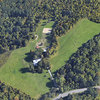New Scotland Hamlet has updated zoning and trails to tie with Hilton Barn
NEW SCOTLAND — The New Scotland Town Board at its April meeting put forward a local law to clean up a part of the zoning code that hamstrung a major development last year and also approved two similar resolutions related to the town’s Hilton park project.
The resolutions approved by board members on April 13 authorized the connection of Hilton Park to the nearby Albany County Helderberg-Hudson Rail Trail and to the Kensington Woods development.
The proposed local law would clarify some confusing language in a section of the town’s hamlet zoning code, adopted in 2018, that, in the words of town planner Nan Stolzenburg, is “related to density and how multi-family dwellings were going to be addressed.”
In June 2021, Richard Long proposed and then tabled a 72-unit apartment project on his property at 2080 New Scotland Road, approximately a quarter-mile from Town Hall. The issue, in Long’s estimation, was the town’s zoning code wasn’t clear as to allowable density of his proposed development.
Representatives for Long argued there were different housing standards in the hamlet district: one said only one home per acre was allowed while another allowed a residential unit every 3,000 square feet. Building Inspector Jeremy Cramer had decided that the one-acre zoning applied and allowed Long’s application to move forward to the zoning board, where he would be able to challenge the one-unit-per-acre determination.
Donald Zee, Long’s attorney, said at the July 2021 zoning board meeting that, when there’s ambiguity in a zoning code, which Zee maintained there was, “the courts have repeatedly found that you have to interpret it in favor of the property owners,” and that his client would be seeking the more favorable multi-family housing density.
During the zoning board’s July meeting, then-Chairman Jeffrey Baker, who now chairs the planning board, said the zoning board was being asked by Long to make an interpretation that was unconnected to his application. “We’re being asked to resolve this apparent inconsistency, to provide guidance to the applicants, to [Cramer] going forward,” Baker said.
The board was being asked to clarify a provision in the zoning that not only impacted Long’s project, but every property in the hamlet district addressed by that section of the code. If the interpretation had been project-specific, the zoning board would have undertaken a State Environmental Quality Review Act review of the Long proposal, Baker said. And if the board were to agree with Long’s interpretation of the code, then future developers would be “able to come forward and say, ‘We want to do multi-family without the one-acre requirement,’” Baker said, in effect changing a section of the code.
Long ended up withdrawing his application for an interpretation in September.
Local Law B of 2021
The New Scotland Hamlet is bounded by the town of Bethlehem to the east, the village of Voorheesville and railroad to the west, the Helderberg-Hudson Rail Trail to the north, and commercial and medium-density residential districts to the south of Route 85.
The zoning adopted in 2018 had a hamlet center subdistrict that included Stonewell Plaza and part of the former Bender melon farm bounded by the property lines of 1891 and 1903 New Scotland Road on its east with an imaginary line running west from the most northern point of the 1891 New Scotland Road property to the 0.7-acre parcel adjacent to 386 Maple Road, where Fred the Butcher’s shop is located.
The expansion and development area subdistricts radiate out from the hamlet center. The proposed Long development was located in the expansion area.
The new law clears up the old law’s permitted uses.
Specifically, the new law would allow for multi-family housing in the hamlet center subdistrict with a special-use permit. But the housing would only be allowed as part of a mixed-use building and the units couldn’t be placed on the first floor of “any commercial or mixed residential/commercial structure,” according to the proposed law.
This piece was added to the new law in support of the town’s vision for the hamlet center subdistrict: Bolstering town support of both business and mixed-used development. To that end, the new zoning would permit multi-unit housing in the hamlet center subdistrict so long as it’s part of a mixed use building. “So this ties … allowing for multi-family dwellings when there is a commercial component in the central district,” Stolzenburg said.
The proposal “basically replaces” the current law’s subsection on base density, Stolzenburg said, which became an issue with Long Lumber.
The new law calculates base density in the hamlet district by using net buildable acreage. This clarifies how the base density is calculated for the hamlet districts by using net buildable acreage, which means first subtracting the environmental constraints on a parcel (like wetlands) before determining how many residential units can be built on the entire parcel.
“There’s quite a bit of text there that walks everybody through those steps of how you get to the buildable acreage,” Stolzenburg said. There had also been confusion in the 2018 zoning over how to calculate density, she said. Long had proposed 72.
In all three hamlet subdistricts — the center as well as the expansion and development areas — the proposed law explicitly states 40 total units would be allowed. However, developers would be eligible for a density bonus “in return for providing certain amenities to the town.”
Among the eight amenities (which is allocated on a point system) a developer can provide the town in exchange for additional units — the maximum which can be 10 — is dedicating 25 percent of total units to affordable senior housing; allowing public use of permanently preserved on-site open space; and a number energy-related provisions.
“I think … in crafting all of these updates, we were cognizant of the goals for the hamlet zones, how the comprehensive plan, discussed and laid out long-term plans and goals for the hamlet,” Stolzenburg said. “The zoning itself has goals for each of the hamlet districts,” and the hope is that “this zoning gets us closer to reaching those ideals.”
New map
A map not included in the agenda packet had a revision to the New Scotland Hamlet zoning map. Town attorney Michael Naughton said during the April 13 meeting, “I understand … that the county’s zoning subdivision maps haven’t been updated yet” to reflect the subdivision of 20 acres from the former Bender melon farm.
In December 2020, the Mohawk Hudson Land Conservancy paid $1 million for the 176-acre property at the corner of routes 85 and 85A. To help pay for the purchase, the conservancy sold 20 of those acres along Route 85, across the road from the Stewart’s Shop and in between Stonewell Plaza and the convent-turned-apartments at 1903 New Scotland Road, for $511,000.
The property was sold to Ron Kay, the developer of the Grove at Maple Point, the 3.2-acre property between Fred the Butcher and Stonewell Plaza, and three others: a limited-liability company registered at the address of his Maple Point partner, Dan Sanders; Sanders’ brother, Alan; and another LLC that shares an address with multiple companies. Kay was recently blamed by a Stonewell Plaza tenant for flooding that happened to her store in November.
The original hamlet center subdistrict did not line up with the 20 acres that the conservancy had subdivided to pay for its purchase of the former Bender melon farm, said Councilman Adam Greenberg.
“It was pretty close, but did not exactly line up with the 20 acres that [the conservancy] sold to Mr. Kay,” he said. “But it makes sense that it does at this point. The Bender melon property cannot be developed. It’s forever wild.” There was an additional hamlet expansion area north of the hamlet center that was stricken from the new map as well because it’s now part of the conservancy’s land that will remain forever wild.
The town board referred the proposed law and its revised zoning map to the town and county planning boards, but held off on setting a public hearing because “there have been a lot of comments about this,” Naughton said. “So you may just want to wait to hear back from the [town] planning board.”
Connecting
With the approval of a third and final payment of approximately $78,000 to Hilton Barn roof contractor Mid-State Industries, board members checked a big item off the town’s to-do list for the Hilton park project.
The roof — slate like the original it replaced — cost about $513,5oo, approximately $61,000 over the original estimate.
In 2016, the town saved the massive historic barn by moving it across Route 85A; a developer had plans to tear it down. Adjacent to Albany County’s popular Helderberg-Hudson Rail Trail, the barn is now surrounded by parkland.
The town is diving right back in at a special meeting set for April 27, where the board will be asked to approve a contract with architectural firm Lacey Thaler Reilly Wilson for $21,300 of design and oversight services for, among other things, a new concrete slab floor in the barn, new bathrooms, and new doors and windows.
At the April 13 meeting, the board approved two connections that will make it easier for rail-trail users to access Hilton Park.
The town’s tie-in has already been approved by the state and has been conceptually designed and would connect about 2,520 feet down the rail trail from the center of Hilton Road at a bridge, near the conservancy’s David’s Trail on what’s now known as Bender Melon Farm Preserve. Councilman William Hennessy said during the April 13 meeting that the conservancy as part of its Earth Day volunteering would be doing some work on the connection, which would have been in addition to a roadside clean-up of Route 85A and work on David’s Trail.
The board also approved a connection from the Kensington Woods, the once-proposed-170-home development just north of the rail trail off of Hilton Road heading to Krumkill Road.
Hennessey said the Kensington Woods connection was in some of the development’s original design documents. He also said it would have a parking lot. Masullo Brothers Builders, the project developer, “has offered to construct the majority of” the connection, Supervisor Douglas LaGrange said.


